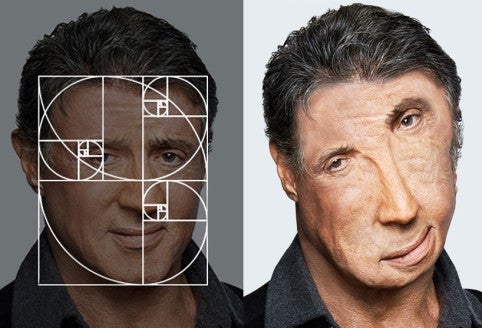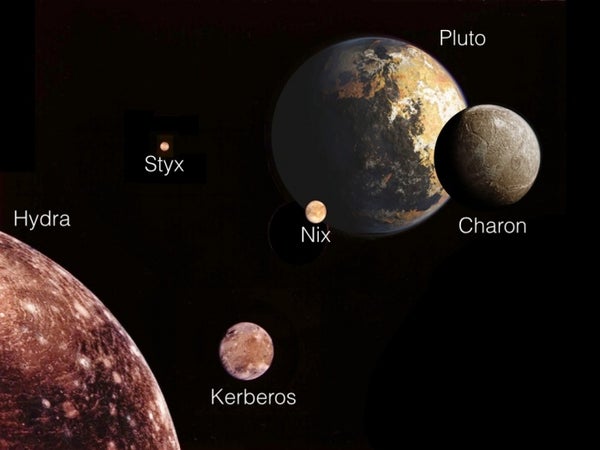This article was published in Scientific American’s former blog network and reflects the views of the author, not necessarily those of Scientific American
Astronomers Describe Chaotic Dance of Pluto’s Moons, which turn out to tumble in orbit, Hubble measurements reveal. Analysis of ten years of data from the space telescope has revealed the unusual trajectories, and also suggests Pluto might in fact be a binary dwarf planet. Pluto’s moons, Nix and Hydra, are the first with irregular rotations, and hence unpredictable sunsets and sunrises. Credit: NASA/JPL/M. Showalter, SETI Institute
LHC arrives at the next energy frontier; data collection has officially begun. After weeks of testing, protons are finally dedicated to experiments in High-Energy Quest For Exotic Physics. Related: Steady to a fault. How do accelerators survive in some of the most earthquake-prone regions on Earth?
Twenty Years Of Bose-Einstein Condensation: "Wieman and Cornell got there first, and the discovery was huge news– the paper was featured on the cover of Science, and jokes about BEC turned up in the monologues of late-night talk shows (“Scientists in Colorado announced that they made the coldest substance in the known universe. They then tricked their little brother into sticking his tongue to it.”). Ketterle’s group at MIT got a BEC soon afterward using about a million sodium atoms."
On supporting science journalism
If you're enjoying this article, consider supporting our award-winning journalism by subscribing. By purchasing a subscription you are helping to ensure the future of impactful stories about the discoveries and ideas shaping our world today.
NASA's 'Warp Drive' Violates Another Law of Physics, Almost Certainly Won't Work.
"Andrew Higgins, a mechanical engineering professor at McGill University in Montreal says that there's another problem with the EmDrive that demonstrates the "absurdity of such a device": It also violates the first law of thermodynamics, which says that energy cannot be created out of nothing."
NASA Has a Fix for the Billion-Dollar Problem of Splattered Bug Guts, based on the lotus leaf.
Atop a sacred mountain, a skirmish between pure science and religion.
A Private View of Quantum Reality: "My wavefunction doesn’t have to align with yours." Quantum theorist Christopher Fuchs explains how to solve the paradoxes of quantum mechanics.
Mystery company blazes a trail in fusion energy. Fusion reactor relies on a "field-reversed configuration": a smoke ring of plasma that holds itself together with its own magnetic field.
Light from distant black holes doesn’t surf on waves of quantum foam. Strongest check yet on quantum gravity effects in astronomy turns up nothing.
The radioactive potassium-40 in every banana emits about 15 particles of antimatter a day.
When the Mona Lisa Is NP-Hard: "mathematician Robert (Bob) Bosch and computer scientist Tom Wexler of Oberlin College are pioneering a technique to turn your favorite masterpiece into a tangle of dots and crossing lines. They call it the figurative tour problem (FTP)."
"Delight is a great way to learn." World Science Festival Finds Success in Physics, and More, as Spectacle.
One nanocrystal, many faces. Imaging of cerium oxide nanocrystals provides new insights into the different behaviors of catalyst for emission control, other uses.
Quantum Physics' Wave-Particle Duality Enigma Bleeds Into the Classical World.
Why Do Spikes Form On Ice Cubes? Physics!
'How to Turn Water Into Wine,' A Clever Demonstration in Liquid Density.
Meet the Real-Life Tony Stark Whose Tech Is Changing the World: John Underkoffler.
Myth busted: Water does swirl in different directions across the globe, but it’s not a toilet thing. Related: At home physics demonstrates the Coriolis effect on both sides of the globe.
Could remnants of the earliest life be preserved in volcanic glass? Strange traces may just be geology.
The UCLA Spinlab demonstrates buoyant convection caused by a local heat source.
Thor’s Hammer Has a Weird Center of Mass in Avengers: Age of Ultron. "After the hammer leaves Thor’s hand, there is only one force acting on it—the gravitational force. Even though the hammer is rotating while in the air, the center of mass should move just like a point particle." Related: A Q&A withAge of Ultron technical consultant Jeff Kahn.
Microscopic Sonic Screwdriver Invented. A team of engineers have created tiny acoustic vortices and used them to grip and spin microscopic particles suspended in water. Related: Science facts behindDr Who sonic screwdriver are even more exciting than fiction.
Watch a ball carve beautiful sand art with the secret power of magnets.
The Emerging Science of Human Computation. The Web has turned the wisdom of the crowd into a valuable, on-demand resource. Now scientists are asking how best to put crowdsourced cognition to work.
Finally, an Algorithm That Tells You Whether or Not a Song’s a Banger.
How maths can change your life: Mathematician Jordan Ellenberg argues that maths can help all of us become sharper thinkers. Related: I was interviewed by the radio show To The Best of Our Knowledge about calculus, along with Ellenberg.
Visualizing Physics for the 6th grade, 1912.
Twelve Illuminating Facts About the General Theory of Relativity. "In 1907, just two years after Einstein published the special theory of relativity, he had the “happiest thought of his life.” It wasn’t about a loved one, a remembrance, some sense of self satisfaction, or even the poetry of the cosmos. It was about a man falling from a building. Einstein realized that a man falling alongside a ball would not be able to recognize the effects of gravity on the ball. ... This connection between gravity and acceleration became known as the equivalence principle."
Here's What it Would Look like if Black Holes Hung in the Night Sky.
What would you see as you fell into a black hole? Would there be only blackness past the event horizon? Or something more? "When you travel towards an object like a moon, planet or star, the closer you get, the larger it appears. Halve the distance and its angular size doubles; reduce the distance to a quarter and it appears four times as large. But for black holes, their gravitation is so strong that relation no longer holds as you approach the event horizon. Instead, the region of “blackness” increases much faster than you’d expect, eventually taking over a full half of the sky as you crossed the event horizon and causing all the light-paths to contract down to a point behind you the instant before you hit the singularity."
Wormholes with Negative Energy. How to build a wormhole for faster-than-light messages.
SNORT (Supersonic Naval Ordnance Research Track) Is Where NASA Engineers Destroy Next-Generation Parachutes.
The universe at your fingertips. Raw images from the DECam Legacy Survey’s new image archive will appear online the day after they are taken.
How Will NASA Land Big Payloads on Mars? Inflatable Donuts, i.e., the Low-Density Supersonic Decelerator.

Credit: Igor Kochmala
How Celebrity Faces Would Look if They Fit the Golden Ratio: "the thinking goes: When these proportions are applied to a design’s structure, the outcome is pleasing to the human eye. Some have even contended that the rule applies to human faces. Igor Kochmala, a Moscow-based web designer, illustrates the fallacy of that opinion with his golden retouching of Hollywood icons.... The lesson: There are no surefire formulas in beauty or good design."
Niels Bohr, the Life Behind the Physics. With his model of the atom, he led physics into the quantum era. In the last of this season’s Perimeter Institute public lectures, his grandson Vilhelm will talk about personality and his influences.
Why we fell out of love with algorithms inspired by nature.
New study shows the dynamics of active swarms in alternating fields.
Hubble Images Turned 3D Are Your Best Chance To Fly Through A Nebula.
Quantum chemistry may be a shortcut to life-changing compounds.
String theory advances philosophy. No, really.
Leonard Susskind: Demystifying the Higgs Boson (video lecture).
Self-Chilling Roof Material Could Cool Your House For Free.
After some initial hiccups, the Planetary Society's Solar Sail Seemed Ready to Deploy in Low-Earth Orbit. But then it Stopped Sending Data Back To Earth … Again
Hubble Witness to Relativistic Crash in a Black Hole Jet.
What Would Happen If All Our Satellites Were Suddenly Destroyed?
On several frequencies, light guides the way to development.
The Fermi Paradox: Life is durable and Earth-like planets aren’t rare. So where are all the aliens?
Happy Birthday, Walt Whitman! Hear Neil Tyson read Whitman's poem, "When I Heard the Learn'd Astronomer."
An Ode to the Graph, Physics’ Underappreciated Workhorse. "the best way to build or verify a model is with a graph."
Read John Nash’s Super Short PhD Thesis with 26 Pages and 2 Citations: The Beauty of Inventing a Field.
Stephen Hawking: 'I would consider assisted suicide.' Physicist tells BBC programme he would consider ending his life if he had nothing more to contribute and was a burden to those around him.
Botanical Mathematicians: "plants can multiply, at least by small numbers, and divide."
MIT Physicists Score a Big Victory in Quantum Error Correction.
A Cosmology Short Story competition, sponsored by the Dark Energy Survey. Deadline is June 15.
Student Confirms That There Are Enormous Tubes Of Plasma Floating Above The Earth.
Electronic Tongue Identifies The Correct Beer — Every Time.
Apple plans to map the inside of buildings -- with robots of course.
Light Origami: Masakazu Shirane’s Immersive 3D Kaleidoscope Made From 320 Origami Shapes.
The Dueling Weathermen of the 1800s. This bitter dispute set the stage for the modern weather forecast. "In 1800 the weather remained a mystery. The sky was the last part of nature to be classified: a relic of the arcane, chaotic world that had existed before Newton and the Scientific Revolution."
Readers suggest the 10 best unsung female scientists.
Light-Up Faraday: a toy to teach electronics and coding.
Using Simple Math for a Great Summer Party Cocktail Hack. "Estimate that every drinking guest will consume one portion per hour, and multiply the number of drinkers times the number of hours."
Better cooking through chemistry. Science and food have been courting each other for over a decade, says Ali Bouzari. It’s time to commit.
'Suit Up', A NASA Documentary About 50 Years of Spacewalks Narrated by Jon Cryer.
